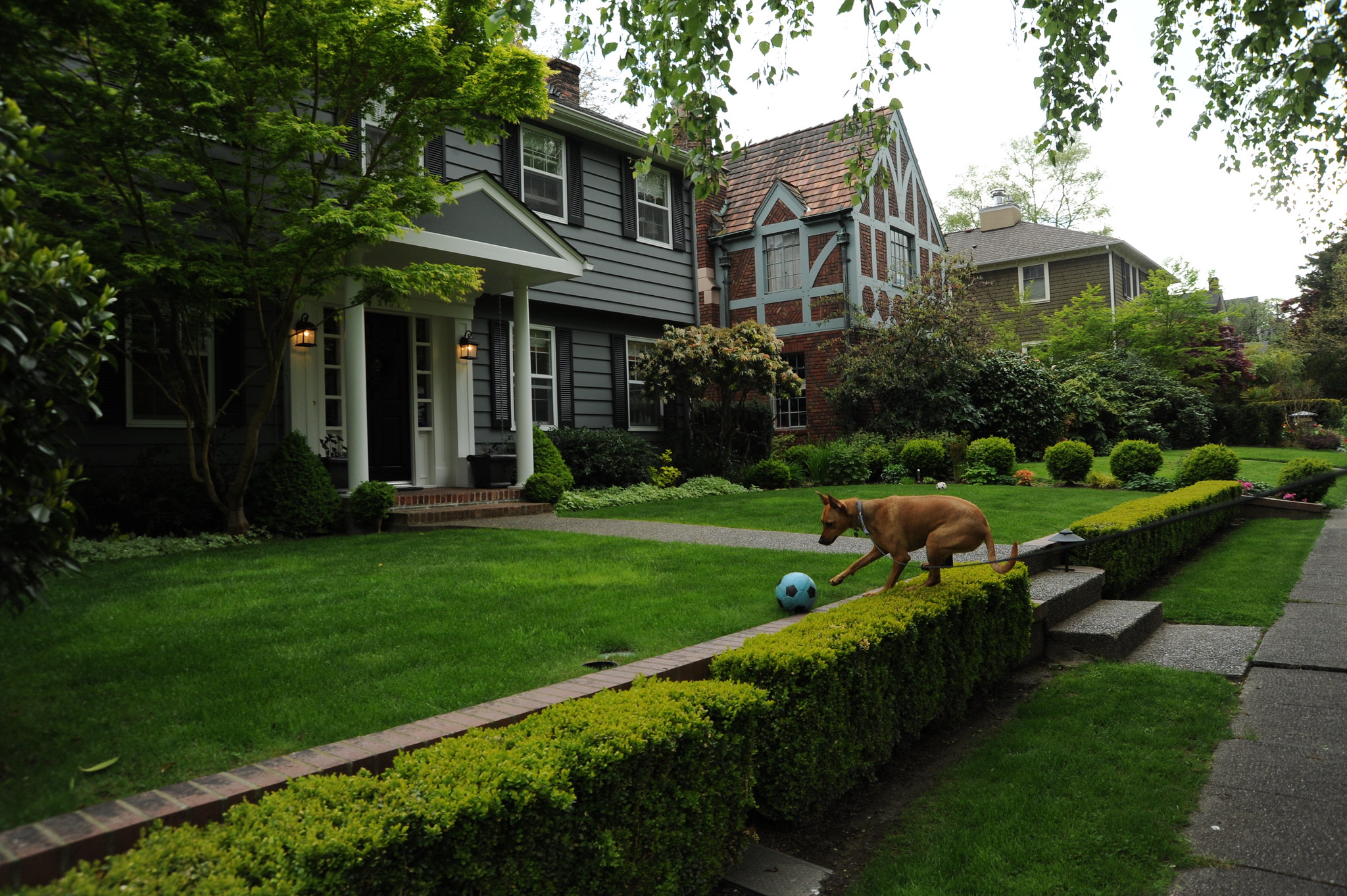
Our guide to eco-friendly lawn care includes simple measures that you can apply today: adopting smart watering strategies, using natural lawn fertilizers, switching to sustainable mowing practices, and managing weeds and pests naturally.
Why Choose Eco-Friendly Lawn Care?
Regular lawn care practices include the use of synthetic fertilizers, herbicides, and pesticides — chemicals that can be dangerous to humans, pets, and the ecosystem. Here are some reasons why eco-friendly lawn care can be a better choice:
- Prolonged exposure to lawn chemicals may lead to diseases.
- Lawn chemical runoff pollutes water sources, disrupting the local environment.
- Regular turfgrass lawns reduce biodiversity by depleting food and shelter for pollinators.
- Adopting an eco-friendly lawn care routine can improve your lawn’s health and looks while protecting the environment.
If you’d rather leave your lawn care entirely in the hands of a local lawn care pro, search for one who offers eco-friendly options.
Smart Watering Strategies
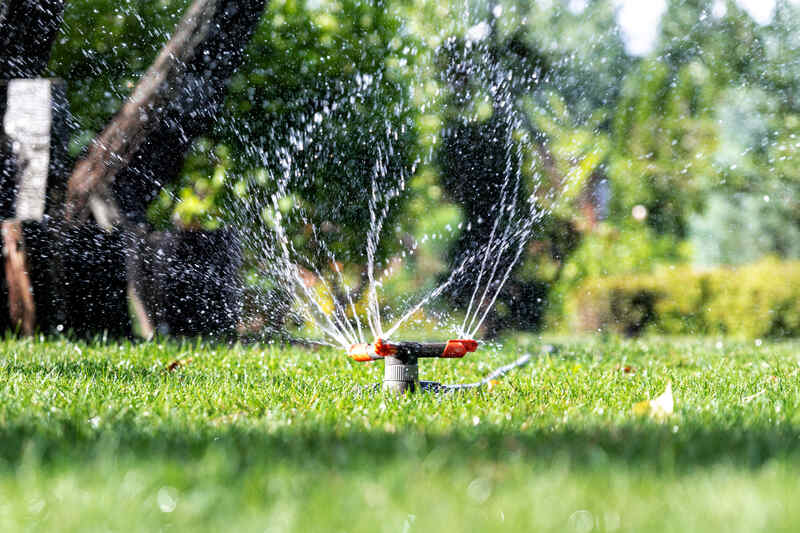
1. Water Deeply and Infrequently
Water your lawn less frequently, but deeply, moistening the topsoil 6 to 8 inches deep. A good rule of thumb is to water your lawn once a week with 1 inch of water, depending on your soil type and local weather. If you’re unsure how often to water your lawn, water it when you see signs of dryness, like footprints that stay on the lawn.
2. Water at the Right Time
The best time to water your lawn is early in the morning (between 5 a.m. and 9 a.m.) so the soil has time to absorb the water before the sun evaporates it.
3. Install a Rain Barrel
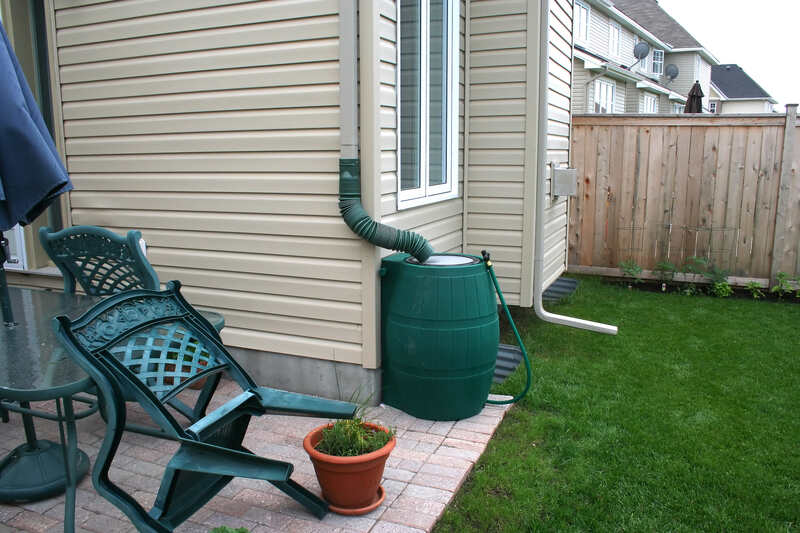
Invest in a rain barrel to collect the rainwater from your gutters. Rain barrels are easy to install and help you save lots on your water bill. You can also set up watering cans during storms to collect rainwater for trees and shrubs. See our article on Rainwater Harvesting Restrictions and Incentives by State for more information.
4. Upgrade Your Irrigation System
Traditional fixed spray heads are less efficient at distributing the water around your lawn. These stationary spray heads often don’t cover your lawn evenly and apply water faster than what the soil can absorb.
Opt for rotary nozzles (NOT rotor heads) that deliver multiple streams of water to save water and ensure your lawn is more saturated. For your yard’s flower beds, shrubs, and trees consider a drip irrigation system, as it can save up to 70% on water compared to regular sprinklers according to the H2O Global News Blog.
See Related: Types of Sprinklers for Your Lawn and Garden
Natural Lawn Fertilization
1. Leave Grass Clippings
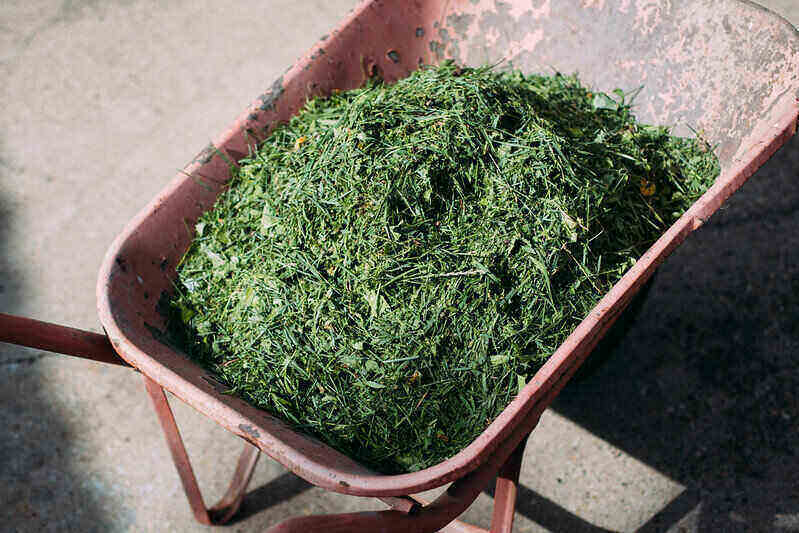
Instead of bagging them, use your grass clippings as mulch. The clippings will decompose and return nutrients to the soil, making an excellent fertilizer. Use a mulching mower or add a mulching plug to your mower to cut clippings into tiny pieces, since long grass clippings can smother your lawn.
Note: Don’t spread your grass clippings if you’re dealing with lawn diseases or active weed problems.
2. Apply Compost
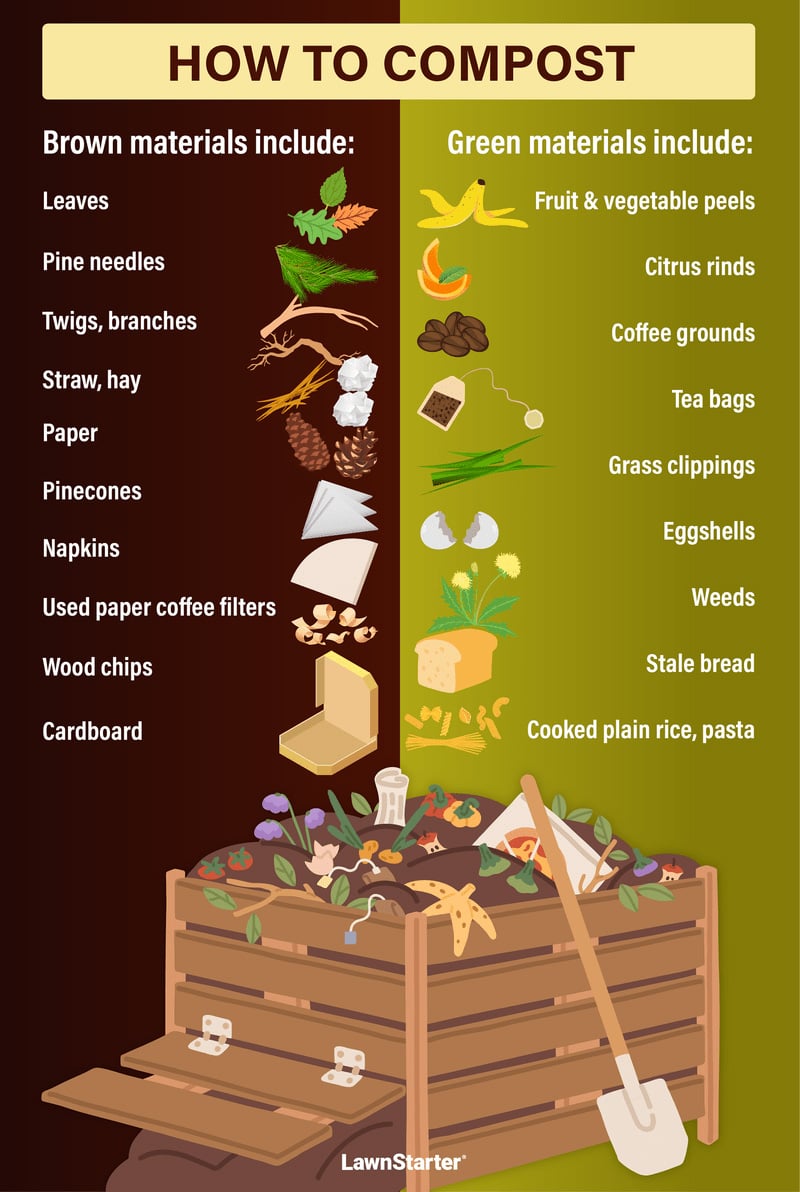
A great way to add organic matter to your lawn (while reducing food waste in your home) is by composting. The finished compost can be added to soil to increase fertility, improve moisture retention, and enhance its overall structure.
If you don’t have a mulching plug or mulching mower, you can also compost your grass clippings by adding them to your compost pile.
Remember: Never compost grass treated with chemicals or synthetic lawn fertilizers.
3. Use Organic Fertilizers
Choosing organic fertilizers that are made from plant or animal matter is also a good way to practice green lawn care.
Aged manure, bone meal, and blood meal fertilizers release nutrients gradually, ensuring your lawn gets a consistent supply without harmful runoff affecting waterways. They also promote soil health by encouraging earthworm populations and supporting normal microbial activity.
Sustainable Mowing Practices
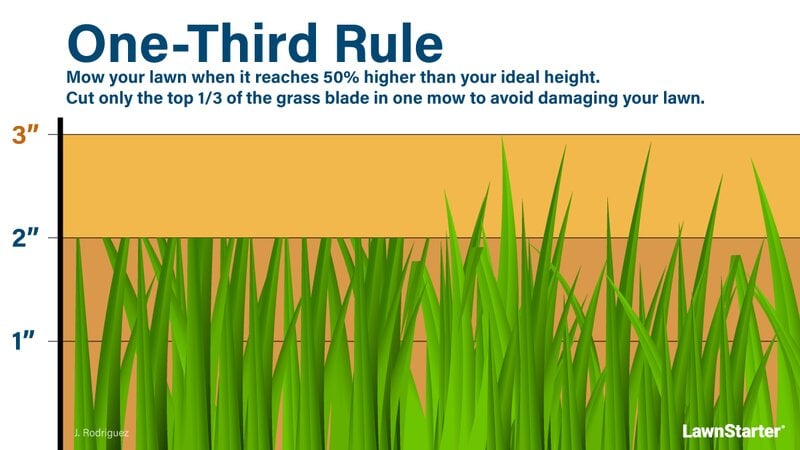
1. Mow Tall, Mow Correctly
Raise your mower’s cutting height up to 1 inch (within your grass type’s recommended mowing range). Mowing the right way and raising your mowing height will give you longer grass blades that absorb more sunlight and grow deeper roots. A strong root system makes your grass more resistant to drought, pests, and diseases.
Also, remember never to cut more than one-third of the grass blade at a time (this is called the one-third rule).
2. Sharpen the Mower Blade
Make sure your mower blades are sharp so that the grass is cleanly cut. Dull blades tear the leaves, making the lawn more susceptible to weeds and diseases.
3. Use Eco-Friendly Mowing Equipment
Less noisy and with no toxic emissions, electric lawn mowers and other electric equipment, such as leaf blowers and trimmers, are the eco-friendly way to do lawn care. Powerful enough to handle small and medium-sized lawns, they’re your next step in supporting an environmentally-conscious neighborhood.
Natural Weed Management
1. Hand-Pull and Spot-Treat
The most effective, eco-friendly approach to control weeds is maintaining a healthy and dense lawn that can naturally outcompete them. However, if a few persistent weeds manage to sprout, use a weeder tool to hand-pull weeds. Alternatively, spot-treat with vinegar (explained in detail below) or other organic herbicides.
2. Corn Gluten Meal
Spread corn gluten meal at a rate of 20 pounds per 1,000 square feet. Corn gluten meal inhibits weed seed germination while providing nutrients to your lawn, acting as an organic weed and feed.
3. Vinegar Solutions
Create a solution by mixing vinegar, dish soap, and water, and spray it directly onto the weeds. This eco-friendly vinegar weed killer can help eliminate individual weeds. You can also use other homemade weed killers to spot-treat these invaders.
Natural Pest Management

Photo Credit: shoma81 / Adobe Stock
1. Integrated Pest Management
For an environmentally-conscious way to deal with pests, adopt an Integrated Pest Management (IPM) approach. In IPM practice, pesticide use is reserved as a last resort, only targets specific pests, and utilizes pesticides in the safest way possible. Here are some IPM principles:
- Bet on good cultural practices. Water, fertilize, and aerate the lawn properly to limit pests and fungi.
- Plant species that are resistant to specific pests and diseases.
- Go for mechanical pest control. It’s a non-chemical lawn care tactic that uses traps, fences, netting, hand picking, etc.
2. Encourage Beneficial Insects
Another way to control pests is by inviting their enemies. Beneficial insects such as ladybugs, spiders, and praying mantises feed on the insects that destroy your lawn or garden. Adding native shrubs, trees, and flowering plants to your garden will provide them with shelter and food.
3. Apply Beneficial Nematodes
Microscopic roundworms that infect and kill lawn grubs and other pests, beneficial nematodes are a biological pest control strategy. These organisms can take care of the pests without harming the environment.
4. Spread Diatomaceous Earth
Use a thin layer of food-grade diatomaceous earth (DE) on your lawn. A form of organic pest control, this powder is made of the fossils of old aquatic organisms (called diatoms). It works mainly by drying out the pests it comes in contact with.
Note: If you already have beneficial insects in your garden, consider opting out of using DE since it can harm beneficial pollinators and insects as well.
Grass Alternatives
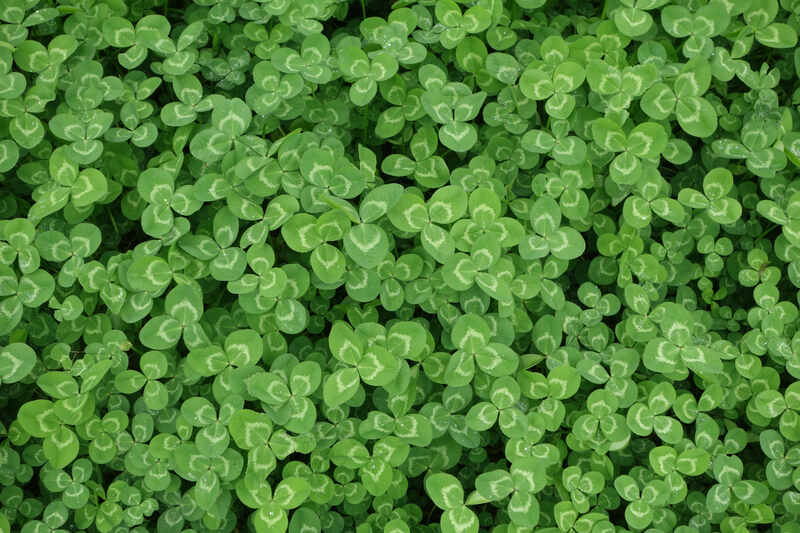
1. Ground Covers
If you don’t like mowing, replace some or your entire lawn with clover or other grass alternatives. Planting a clover lawn not only benefits you and your budget (since it requires less maintenance), but also contributes to the ecosystem.
You can also plant creeping sedum, periwinkle, and a variety of other ground covers that will provide bees and other pollinators with delicious pollen.
2. Native Plants and Gardens
Adding native plants to your lawn is a smart way to practice eco-friendly lawn care. Not only do native plants look pretty, but they also promote biodiversity, are low-maintenance, and help control erosion due to their deep root systems stabilizing the soil.
See our article on native plants for your pollinator garden to find the best options for your eco-friendly yard. You can use native plants to build a pollinator garden, a butterfly garden, a wildflower garden or even a water garden.
3. Hardscapes, Rock Gardens, etc.
Add non-living elements such as backyard patios, pathways, and eco-friendly fencing options. A rock garden can be a great lawn alternative that is eco-friendly and low-maintenance. With a simple setup, you can create an inviting space in your backyard without harming the environment.
Soil Health
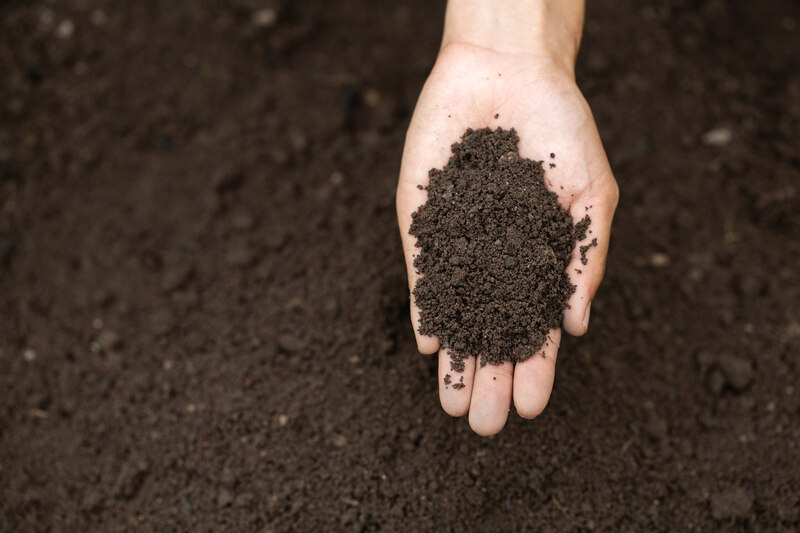
1. Annual Soil Testing
Soil health is one of the pillars of eco-friendly lawn care. Testing your soil annually is a crucial step because it helps you understand exactly the right fertilizer type and amount needed for your soil, avoiding fertilizer runoff that pollutes the local water systems.
You can use a soil test kit or send a soil sample to your local Cooperative Extension for lab testing for precise, detailed results.
2. Aeration
Soil aeration is another important practice for soil health. Aeration helps improve compacted soil and allows nutrients to better infiltrate the soil. Overseed your lawn after aerating so your grass will grow fuller and more competitive against weeds.
Note: It’s also important to dethatch your lawn if you notice more than 1/2 inch of thatch.
3. Build Organic Matter
Your soil test results will show the condition of your soil, and depending on the results, it might need organic matter to improve its quality. Some of the best types of soil amendments to build organic matter are compost, aged manure, and worm castings.
FAQ About Eco-Friendly Lawn Care
Yes, your lawn can look just as good with an eco-friendly lawn care routine, but you’ll need to be patient. Although using chemicals gives you quicker results, organic lawn care gives you lasting results and is a great choice for your lawn health and the environment.
The best organic matter for lawn soil depends on the pH and texture of your soil. In general, however, compost is one of the best options. You can also use shredded grass clippings, shredded leaves, aged manure, humus, and worm castings.
Start Your Eco-Friendly Lawn Today
Starting your journey into eco-friendly lawn care can be overwhelming, but it’s worth it, and you’ve got help. LawnStarter can connect you with the best eco-friendly lawn care pros to support you in this amazing project. Get in touch today.
Sources:
- “The Facts About Lawn Chemicals.” By Mid-America Regional Council.
- “Drip Irrigation and Water Management.” By H2O Global News.
- ”Healthy Lawn, Healthy Environment: Caring for Your Lawn in an Environmentally Friendly Way.” By the United States Environmental Protection Agency.
- “Natural Organic Lawn Care.” By horticultural experts Jane C. Martin, Alyn Eickholt, Joanne Dole, Kris Lazslo, and Renee Yurovich. Ohio State University Extension in Franklin County.
Main Image Credit: Wonderlane / Flickr / CC0 1.0